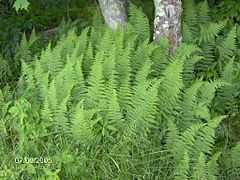Dennstaedtia punctilobula
| Dennstaedtia punctilobula | |
|---|---|
 | |
| Conservation status | |
| Scientific classification | |
| Kingdom: | Plantae |
| Division: | Pteridophyta |
| Class: | Pteridopsida |
| Order: | Dennstaedtiales |
| Family: | Dennstaedtiaceae |
| Genus: | Dennstaedtia |
| Species: | D. punctilobula |
| Binomial name | |
| Dennstaedtia punctilobula (Michx.) T.Moore | |
| Synonyms | |
|
Dicksonia punctilobula | |
Dennstaedtia punctilobula (Hay-scented Fern) is a species of fern native to eastern North America, from Newfoundland west to Wisconsin and Arkansas, and south in the Appalachian Mountains to northern Alabama; it is most abundant in the east of its range, with only scattered populations in the west.[1]
It is a deciduous fern with fronds growing to 40–100 cm (rarely 130 cm) tall and 10–30 cm broad; the fronds are bipinnate, with pinnatifid pinnules about three times as long as broad. It occurs in damp or dry acidic soils in woods or open woods, from sea level up to 1,200 m altitude.[1]
Dennstaedtia punctilobula can exhibit varying degrees of phototropism. The common name "Hay-scented Fern" comes from the fact that crushing it produces an aroma of fresh hay.
The presence of Dennstaedtia punctilobula influences the dynamics of the understory vegetation of many forests in the eastern United States. An abundance of Rubus allegheniensis in open areas encourages new tree seedlings. Where the effects of herbivorous animals (such as deer) reduce the abundance of Rubus allegheniensis, Dennstaedtia punctilobula, which is not browsed by deer, takes over. Where Dennstaedtia punctilobula becomes common, the growth of tree seedlings is restricted.[2]
References
- ↑ 1.0 1.1 Nauman, Clifton E.; Evans, A. Murray (1993). "Dennstaedtia punctilobula". In Flora of North America Editorial Committee. Flora of North America. Flora of North America North of Mexico 2 (New York and Oxford: Oxford University Press).
- ↑ Levin, Simon A., ed. (2009). "Wildlife Management". The Princeton Guide to Ecology. Princeton: Princeton University Press.
